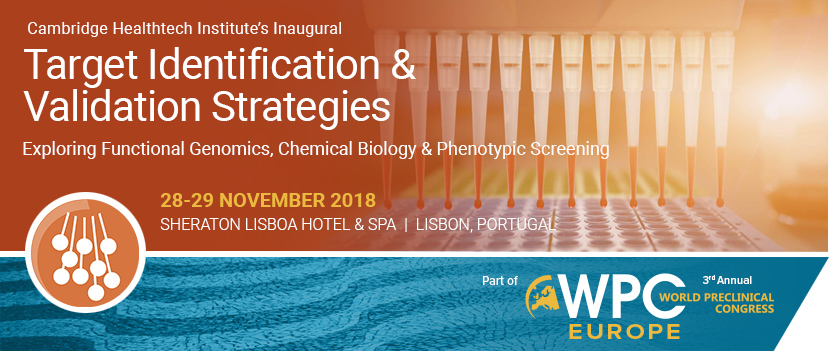
Finding novel, druggable targets for therapeutic intervention remains a top priority for the pharma/biotech industry, especially when it comes to building a robust drug discovery pipeline. It also remains a formidable challenge and companies continue
to invest a lot of time and resources in identifying and validating good drug targets to pursue. What are the challenges in target discovery? What tools and strategies are being used and how well are they working? What’s being done to ensure
that validated targets lead to better and safer therapies? Cambridge Healthtech Institute’s Inaugural Target Identification & Validation Strategies conference will bring together
leading experts to discuss some of these critical questions. The talks will highlight how functional genomics, phenotypic screening and chemical biology can be used to find new drug targets, validate existing targets for new indications, and to better
understand how inhibiting or activating these targets could impact cellular pathways. The conference will help attendees meet and interact with experts and peers from around the world to share ideas and hear about new strategies and technologies helping
target discovery.
Final Agenda
Day 1 | Day 2 | Download Brochure
Recommended All Access Package:
27 November: Artificial Intelligence and Machine Learning for Drug Discovery
27 November Dinner Course: SC3: The Origins, Optimization and Application of Organ-on-a-Chip Systems
28-29 November: Target Identification and Validation Strategies
29-30 November: CNS Models and Translational Strategies
29 November Dinner Course: SC5: Humanized Mouse Models: Technology and Applications in Preclinical Assessment of Cancer Immunotherapy
Wednesday 28 November
7:00 Registration and Morning Coffee
8:50 Welcome Remarks
Tanuja Koppal, PhD, Conference Director, Cambridge Healthtech Institute
8:55 Chairperson’s Remarks
John Doench, Ph.D., Associate Director, Genetic Perturbation Platform, Broad Institute of Harvard and MIT
9:00 Up, Down, and Out: Multiplexing CRISPR Modalities for Genetic Screens
 John Doench, PhD, Associate Director, Genetic Perturbation Platform, Broad
Institute of Harvard and MIT
John Doench, PhD, Associate Director, Genetic Perturbation Platform, Broad
Institute of Harvard and MIT
The ease of programming Cas9 with an sgRNA presents an abundance of potential target sites, but the on-target activity and off-target effects of individual sgRNAs can vary. We will discuss the design and use of libraries for CRISPR-based knockout screens,
activation (CRISPRa) and interference (CRISPRi) technologies, and combinatorial approaches.
10:00 Grand Opening Coffee Break in the Exhibit Hall with Poster Viewing
10:45 Geometry and Genome editing: A Comparative Analysis of Targeted siRNA and CRISPR Arrayed Screens in 3D
 Madhu
Lal-Nag, PhD, Group Leader, Trans-NIH RNAi Facility, National Center for Advancing Translational Sciences, National Institutes of Health
Madhu
Lal-Nag, PhD, Group Leader, Trans-NIH RNAi Facility, National Center for Advancing Translational Sciences, National Institutes of Health
The recent emergence of CRISPR/Cas9-based technologies has led to the development of several orthogonal approaches for functional genomic screening that complement or improve upon existing RNAi screening approaches. Thus far, CRISPR screens have been
mostly performed within an individual laboratory setting where expertise exists, for example, those employing a pooled library approach with a simple phenotype such as cell survival. However, here we describe the development of a robust, reproducible,
and flexible CRISPR/Cas9-based high-throughput screening (HTS) workflow that is compatible with the assessment of more complex phenotypic assays.
11:15 CRISPR-UMI: Single Cell Lineage Tracing of Pooled CRISPR/Cas9 Screens
 Ulrich Elling, PhD, Principle Investigator, Institute of Molecular
Biotechnology Austria (IMBA)
Ulrich Elling, PhD, Principle Investigator, Institute of Molecular
Biotechnology Austria (IMBA)
Pooled CRISPR screens are a powerful tool to assess gene function. We developed CRISPR-UMI (Unique Molecular Identifiers), a single cell lineage tracing methodology for pooled screening to account for cell heterogeneity. The added value of CRISPR-UMI
will be presented for positive and negative selection paradigms including synthetic lethal screens. CRISPR-UMI controls for inherent noise in genetic screens, increases reproducibility, and enables quantitative phenotyping.
11:45 Enjoy Lunch on Your Own
13:45 Chairperson’s Remarks
Ulrich Elling, PhD, Principle Investigator, Institute of Molecular Biotechnology Austria (IMBA)
13:50 Filling the Drug Discovery Gap: Is High-Content Screening the Missing Link?
Jean-Philippe Stephan, PhD, Director Servier Center of Excellence Pharmacological Screening, Compound Management and Biobanking, Institut de Recherches Servier
The pharmaceutical industry is now implementing new discovery paradigms to try to solve the current disconnect between drug discovery and human clinical trials. High-Content Screening (HCS) combined with biosensors, genome-editing and stem cell-derived
cellular models offer the opportunity to drastically transform phenotypic screening, linking target engagement and phenotypic impacts in more relevant in vitro models. Despite the tremendous potential of HCS, researchers have to carefully consider
various aspects before deploying the technology and this presentation will go through several examples highlighting the current strengths and weaknesses of the approach.
14:20 Target Deconvolution and Validation Strategies for Antibodies from Target-Agnostic Phenotypic Screens
Alan Sandercock, PhD, Scientist II, Department of Antibody Discovery and Protein Engineering, MedImmune
Phenotypic screening methods can be applied to biological drug discovery to find novel functional targets and, in some cases, drug leads direct from target-agnostic screens. Target identification is often challenging, but is vital for characterising and developing a therapeutic antibody. The subsequent path from target ID to validation can be long, especially where poorly understood biological pathways are encountered. Here, we will describe how our approaches have evolved to allow phenotypic screening to supplement a target-led biologics portfolio.
14:50 Interactive Breakout Discussion Groups - View Details
This session features various discussion groups that are led by a moderator/s who ensures focused conversations around the key issues listed. Attendees choose to join a specific group and the small, informal setting facilitates sharing of ideas and active
networking.
CRISPR/Cas9 for Drug Discovery Applications
Moderators: John Doench, PhD, Associate Director, Genetic Perturbation Platform, Broad Institute of Harvard and MIT
Use of Chemical Biology and Chemical Probes in Drug Discovery
Moderator: Paul Brennan, Ph.D., Associate Professor, Medicinal Chemistry, University of Oxford and Principal Investigator, Target Discovery Institute, Structural Genomics Consortium
- Main applications of Chemical Biology in Drug Discovery projects
- When should Chemical Biology be used in Discovery programs?
- Labelled and label-free proteomic techniques for target identification
16:00 Refreshment Break in the Exhibit Hall with Poster Viewing
16:45 A High Density CRISPR Tiling Mutagenesis Genetic Screen for Target Deconvolution
 Dirk Daelemans, PhD, Associate Professor, Rega Institute
- Laboratory of Virology and Chemotherapy, KU Leuven
Dirk Daelemans, PhD, Associate Professor, Rega Institute
- Laboratory of Virology and Chemotherapy, KU Leuven
Deconvoluting the direct molecular target of hits from a complex phentotypic high-throughput screen or validating the target of hits from a biochemical screen in a more complex system is still a major challenge but required for further drug development.
The discovery of mutations that confer resistance is recognized as the gold standard proof for target engagement. Exploiting the error prone non-homologous end joining after CRISPR-induced double strand breaks, we have developed a high-density tiling
CRISPR genetic screen to rapidly deconvolute the target protein and binding site of small-molecule inhibitors based on resistance mutations. The CRISPR guides directly annotate the resistance mutations avoiding the need for whole transcriptome sequencing.
17:15 Unbiased Compound-Target Interface Mapping through Forward Genetics
Moritz Horn, PhD, Postdoctoral Fellow, Laboratory of Dr. Martin Denzel, Max Planck Institute for Biology of Ageing
We present a chemical mutagenesis approach to map compound binding interfaces in forward genetic screens and exemplify this for several compounds. We leverage haploid embryonic stem cells as genetic tool to reveal loss-of-function, gain-of-function, and separation-of-function mutations, since chemical mutagenesis in haploid cells can uncover recessive traits. In summary, chemical mutagenesis combined with deep sequencing allows to identify drug targets at amino acid resolution in an unbiased genome-wide scale.
17:45 Concurrent Toxicity and Efficacy Evaluations of Lead Compounds Utilizing Multi-organ Functional Human-on-a-chip Systems
 James J. Hickman, PhD, Founding Director, NanoScience Technology Center and Professor, Nanoscience Technology, Chemistry, Biomolecular Science, Material Science and Electrical Engineering, University of Central Florida
James J. Hickman, PhD, Founding Director, NanoScience Technology Center and Professor, Nanoscience Technology, Chemistry, Biomolecular Science, Material Science and Electrical Engineering, University of Central Florida
Phenotypic screening systems for lead optimization have the advantage of providing useful information without a known target. Human-on-chip systems can potentially establish a therapeutic index before evaluation in animal models or clinical trials
and also gives the possibility of target identification. Examples of multi-organ systems being developed for cancer and other diseases and conditions as well as the results of six Workshops held at NIH for validation and qualification will be
presented.
18:15 Welcome Reception in the Exhibit Hall with Poster Viewing
19:15 Close of Day
Day 1 | Day 2 | Download Brochure
Thursday 29 November
8:00 Registration and Morning Coffee
8:55 Chairperson’s Remarks
Paul Brennan, PhD, Associate Professor, Medicinal Chemistry, University of Oxford; Principal Investigator, Target Discovery Institute, Structural Genomics Consortium
9:00 KEYNOTE PRESENTATION: Chemical Probes in Target Discovery
 Paul Brennan, PhD, Associate Professor, Medicinal Chemistry, University of Oxford; Principal Investigator, Target Discovery Institute, Structural Genomics Consortium
Paul Brennan, PhD, Associate Professor, Medicinal Chemistry, University of Oxford; Principal Investigator, Target Discovery Institute, Structural Genomics Consortium
Chemical probes are selective small molecule inhibitors that can be used in cellular assays to induce a phenotype and link it to a small set of protein targets. Chemical probes have been developed for many bromodomains, the principal epigenetic readers
of histone lysine acetylation, and been used to decipher the biology of bromodomains in cancer and inflammation. We are currently developing chemical probes for new protein families.
10:00 Coffee Break in the Exhibit Hall. Last chance for poster viewing.
10:45 Large-Scale Chemogenomics Data: An Enabler for Early Drug Discovery
Florian Nigsch, PhD, Chemical Biology and Therapeutics Informatics, Novartis Institutes for BioMedical Research
This talk will showcase the impact of the integration of large-scale chemogenomics data on a range of activities in early drug discovery. Topics covered will include pre- and post-screening activities, tool compound discovery, chemoproteomics, as
well as applications that link compounds and their transcriptional profiles.
11:15 Chemo-Genomic Screening in AML: A New Approach to Identify Therapeutic Strategies in Cancer
 Anne Marinier, PhD, Principal Investigator and Director of Medicinal Chemistry, IRIC and Associate Professor, Department of Chemistry, Université de Montréal
Anne Marinier, PhD, Principal Investigator and Director of Medicinal Chemistry, IRIC and Associate Professor, Department of Chemistry, Université de Montréal
Capitalizing on new leukemia stem cell culture conditions, we developed a chemo-genomic screening approach using genetically and clinically characterized acute myeloid leukemia (AML) specimens and a structurally diverse compound collection. Clustering
of hits demonstrating similar specimen inhibition patterns generated CCCs (Compound Correlation Clusters) which reveal sensitized target pathways essential to tumor survival. The CCCs therapeutic relevance will be exemplified by the identification
of a novel target for poor prognosis AML.
11:45 A High-Throughput Imaging-Genetic Screen Identifies MEK-PI3K Modulation for TNBC
 Arvind Rao, PhD, Associate Professor, Department of Computational Medicine and Bioinformatics, University of Michigan
Arvind Rao, PhD, Associate Professor, Department of Computational Medicine and Bioinformatics, University of Michigan
As combination therapies enter mainstream clinical oncology, there is now a need for infrastructure to integrate multiple modalities of data to prioritize drug combinations rationally. In this vein, we examine a scenario using machine learning methods
to prioritize drug combinations selected based on phenotypic screening via RNAi, coupled with known genetic vulnerabilities in Triple Negative Breast Cancer cells. Such a strategy leverages imaging and genetic information to prioritize the MEKi+PI3Ki
combination as a possible regimen.
12:15 Close of Conference
Day 1 | Day 2 | Download Brochure